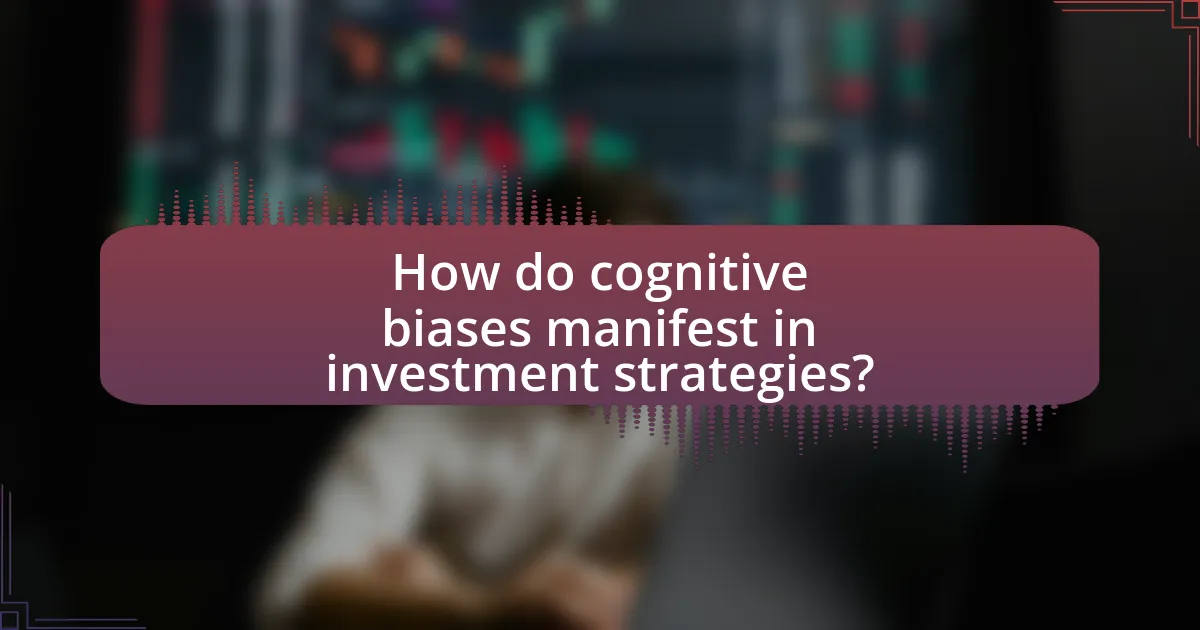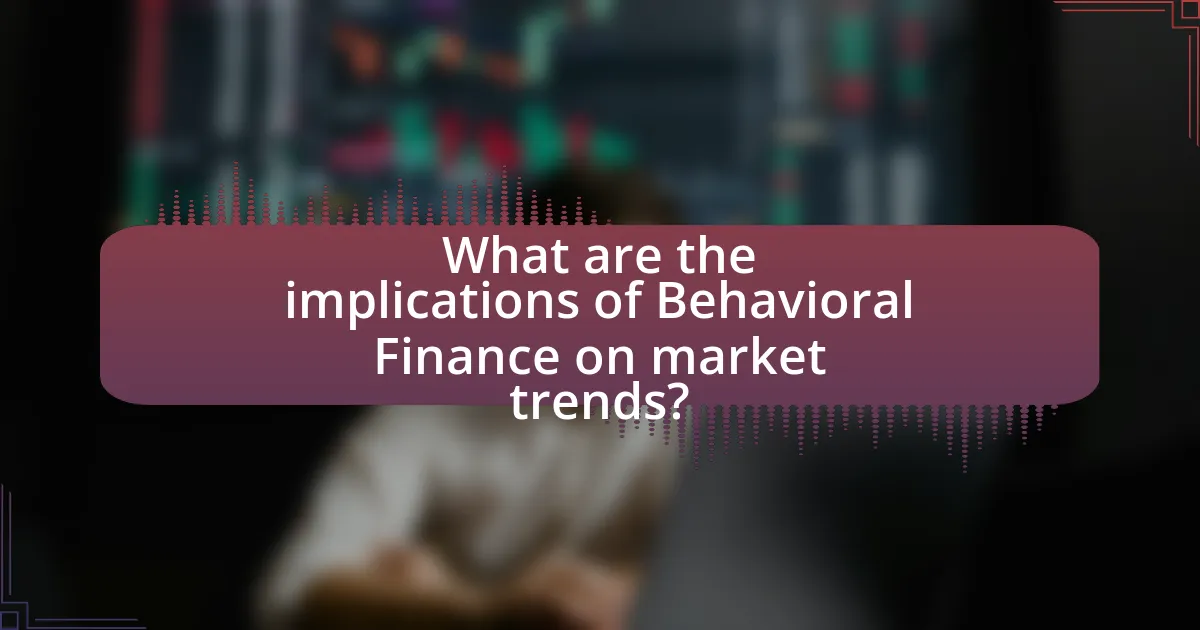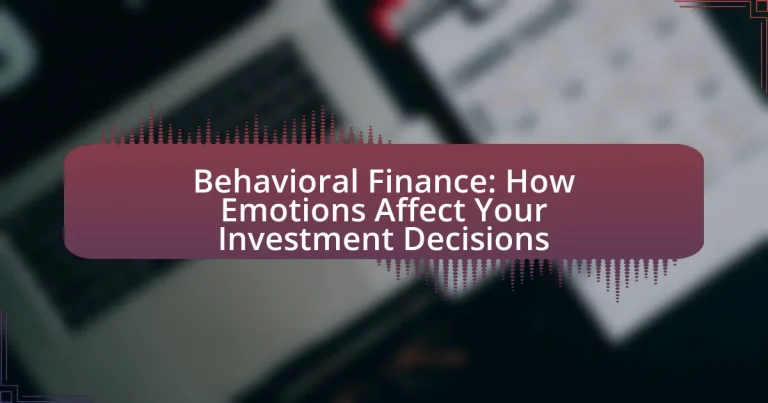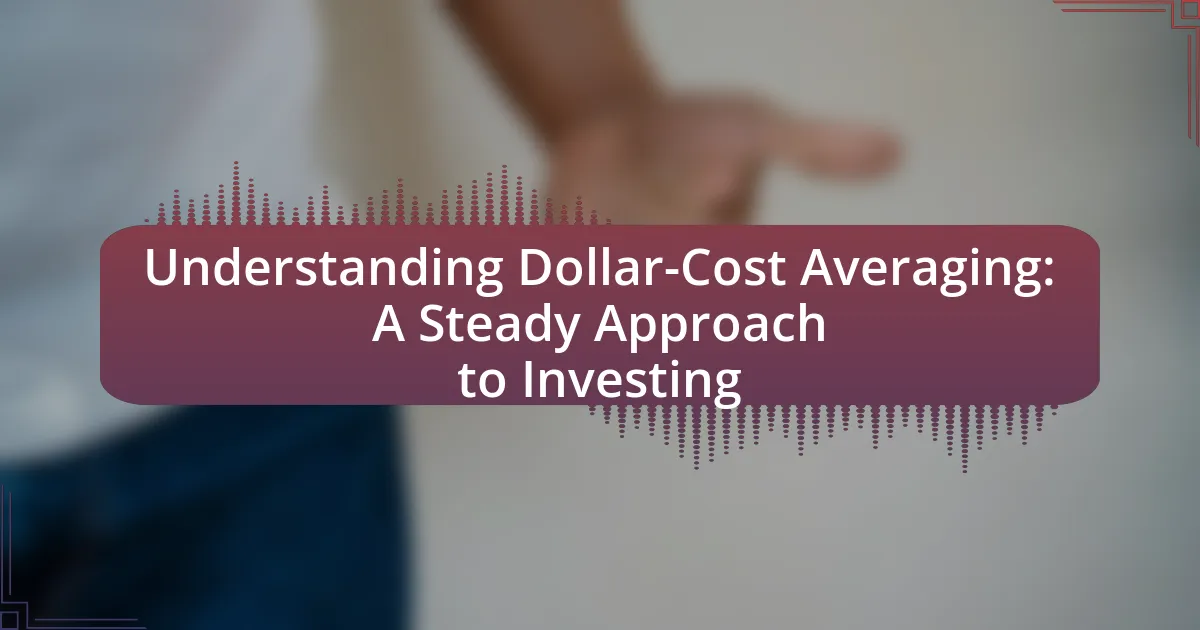Behavioral finance is a field that explores the impact of psychological influences and cognitive biases on the financial behaviors of individuals and markets. It contrasts with traditional finance by acknowledging that emotions, such as fear and greed, can lead to irrational decision-making, resulting in market anomalies. Key principles include cognitive biases like overconfidence and loss aversion, which affect investment strategies and outcomes. Understanding these psychological factors is crucial for investors to mitigate biases, make rational decisions, and improve their investment performance, particularly in the context of market trends influenced by collective emotions and investor sentiment.

What is Behavioral Finance?
Behavioral finance is a field of study that examines how psychological influences and cognitive biases affect the financial behaviors of individuals and markets. This discipline integrates insights from psychology and economics to explain why people often make irrational financial decisions, such as overreacting to news or following herd behavior. Research has shown that emotions like fear and greed can significantly impact investment choices, leading to market anomalies that traditional financial theories struggle to explain. For instance, studies indicate that investors tend to sell winning stocks too early while holding onto losing stocks for too long, a phenomenon known as the disposition effect.
How does Behavioral Finance differ from traditional finance?
Behavioral finance differs from traditional finance primarily in its consideration of psychological factors that influence investor behavior. Traditional finance assumes that investors are rational and make decisions based solely on available information and logical analysis, while behavioral finance recognizes that emotions, cognitive biases, and social influences can lead to irrational decision-making. For example, studies have shown that investors often exhibit overconfidence, leading them to underestimate risks, which contradicts the rational expectations model of traditional finance. This distinction highlights the importance of understanding human behavior in financial markets, as evidenced by phenomena such as market bubbles and crashes that cannot be explained by traditional financial theories alone.
What are the key principles of Behavioral Finance?
The key principles of Behavioral Finance include the concepts of cognitive biases, emotional influences, and the impact of social factors on investment decisions. Cognitive biases, such as overconfidence and loss aversion, lead investors to make irrational choices that deviate from traditional financial theories. Emotional influences, including fear and greed, can drive market fluctuations and affect individual decision-making processes. Additionally, social factors, such as herd behavior, demonstrate how the actions of others can sway an investor’s choices, often leading to market bubbles or crashes. These principles highlight the psychological aspects that significantly shape financial behavior and market dynamics.
Why is understanding Behavioral Finance important for investors?
Understanding Behavioral Finance is important for investors because it helps them recognize how psychological factors influence their investment decisions. Investors often fall prey to biases such as overconfidence, loss aversion, and herd behavior, which can lead to suboptimal financial choices. Research indicates that these biases can significantly impact market trends and individual portfolio performance. For instance, a study by Barber and Odean (2000) found that individual investors who traded frequently underperformed the market due to emotional decision-making. By understanding Behavioral Finance, investors can mitigate these biases, make more rational decisions, and ultimately improve their investment outcomes.
What role do emotions play in investment decisions?
Emotions significantly influence investment decisions by affecting risk perception and decision-making processes. Investors often experience fear and greed, which can lead to irrational behaviors such as panic selling during market downturns or overconfidence in rising markets. Research indicates that emotional responses can result in biases, such as loss aversion, where the pain of losing money is felt more acutely than the pleasure of gaining the same amount, leading to suboptimal investment choices. For instance, a study by Kahneman and Tversky in 1979 introduced Prospect Theory, demonstrating how emotions shape economic decisions, highlighting that emotional factors can lead to deviations from rational behavior in financial markets.
How do fear and greed influence market behavior?
Fear and greed significantly influence market behavior by driving investor decisions and market trends. Fear often leads to panic selling, causing stock prices to drop as investors rush to liquidate their holdings to avoid losses. For instance, during the 2008 financial crisis, fear prompted widespread sell-offs, resulting in a market decline of over 50% from its peak. Conversely, greed can lead to excessive risk-taking and overvaluation of assets, as seen in the dot-com bubble of the late 1990s, where investor enthusiasm drove stock prices to unsustainable levels. This duality of fear and greed creates volatility in the markets, as emotional responses can lead to irrational decision-making, impacting overall market stability.
What psychological biases affect investor decisions?
Psychological biases that affect investor decisions include overconfidence, loss aversion, anchoring, and herd behavior. Overconfidence leads investors to overestimate their knowledge and predictive abilities, often resulting in excessive trading and risk-taking. Loss aversion causes investors to fear losses more than they value gains, which can lead to holding losing investments too long. Anchoring occurs when investors rely too heavily on the first piece of information they encounter, affecting their decision-making process. Herd behavior drives individuals to follow the actions of a larger group, often leading to market bubbles or crashes. These biases have been documented in various studies, such as those by Daniel Kahneman and Amos Tversky, which highlight how cognitive biases influence financial decisions.
What are the common emotional biases in investing?
Common emotional biases in investing include overconfidence, loss aversion, and herd behavior. Overconfidence leads investors to overestimate their knowledge and predictive abilities, often resulting in excessive trading and risk-taking. Loss aversion causes individuals to prefer avoiding losses over acquiring equivalent gains, which can lead to holding losing investments too long. Herd behavior occurs when investors follow the actions of others, often leading to market bubbles or crashes. Research by Barber and Odean (2001) in “Boys Will Be Boys: Gender, Overconfidence, and Common Stock Investment” highlights how overconfidence can lead to poor investment decisions, while studies by Kahneman and Tversky (1979) in “Prospect Theory: An Analysis of Decision under Risk” demonstrate the impact of loss aversion on investor behavior.
How does overconfidence impact investment choices?
Overconfidence significantly impacts investment choices by leading investors to overestimate their knowledge and abilities, which can result in poor decision-making. Research indicates that overconfident investors tend to trade more frequently, believing they can time the market effectively, yet studies show that excessive trading often leads to lower returns. For instance, a study by Barber and Odean (2000) found that individual investors who traded the most underperformed the market by an average of 6.5% annually due to high transaction costs and poor timing. This evidence illustrates that overconfidence can distort risk assessment and lead to suboptimal investment strategies.
What is loss aversion and how does it affect investors?
Loss aversion is a psychological phenomenon where individuals prefer to avoid losses rather than acquiring equivalent gains, meaning the pain of losing is psychologically more impactful than the pleasure of gaining. This affects investors by leading them to make irrational decisions, such as holding onto losing investments longer than advisable to avoid realizing a loss, which can result in greater financial detriment over time. Research by Kahneman and Tversky in their 1979 paper “Prospect Theory: An Analysis of Decision under Risk” demonstrates that loss aversion significantly influences risk-taking behavior, causing investors to be overly cautious or to miss out on profitable opportunities due to fear of loss.

How do cognitive biases manifest in investment strategies?
Cognitive biases manifest in investment strategies through systematic errors in judgment that affect decision-making. For instance, overconfidence bias leads investors to overestimate their knowledge and predictive abilities, often resulting in excessive trading and risk-taking. Research by Barber and Odean (2000) found that overconfident investors traded 45% more than their less confident counterparts, which negatively impacted their returns. Additionally, loss aversion causes investors to hold onto losing investments longer than advisable, as they fear realizing losses, which can lead to suboptimal portfolio performance. A study by Kahneman and Tversky (1979) demonstrated that individuals prefer avoiding losses to acquiring equivalent gains, influencing their investment choices. These biases illustrate how psychological factors can significantly distort rational investment strategies.
What are the most prevalent cognitive biases in investing?
The most prevalent cognitive biases in investing include overconfidence bias, loss aversion, anchoring, and herd behavior. Overconfidence bias leads investors to overestimate their knowledge and predictive abilities, often resulting in excessive trading and risk-taking. Loss aversion causes investors to fear losses more than they value gains, which can lead to holding onto losing investments too long. Anchoring occurs when investors rely too heavily on the first piece of information they receive, affecting their decision-making. Herd behavior drives individuals to follow the actions of a larger group, often leading to market bubbles or crashes. These biases have been documented in various studies, including research by Barber and Odean (2001) that highlights overconfidence in trading behavior, and Kahneman and Tversky’s work on loss aversion, which demonstrates its impact on investment choices.
How does confirmation bias influence investment research?
Confirmation bias significantly influences investment research by causing investors to favor information that confirms their pre-existing beliefs while disregarding contradictory data. This cognitive bias leads investors to selectively search for, interpret, and remember information that aligns with their investment thesis, which can result in poor decision-making. For instance, a study published in the Journal of Behavioral Finance by Barberis and Thaler (2003) illustrates how investors often overreact to news that supports their views, leading to inflated stock prices for favored companies and undervalued stocks for those that contradict their beliefs. This behavior can distort market efficiency and contribute to asset bubbles or crashes, demonstrating the tangible impact of confirmation bias on investment outcomes.
What is anchoring bias and how does it affect decision-making?
Anchoring bias is a cognitive bias that occurs when individuals rely too heavily on the first piece of information encountered (the “anchor”) when making decisions. This bias affects decision-making by causing people to give disproportionate weight to the initial information, which can skew their judgment and lead to suboptimal choices. For example, in financial contexts, if an investor sees a stock priced at $100 and later learns it is now $80, they may perceive it as a bargain based on the initial anchor, even if the stock’s true value is lower. Research by Tversky and Kahneman in 1974 demonstrated that individuals often make estimates based on irrelevant anchors, illustrating how anchoring can lead to systematic errors in judgment and decision-making.
How can investors recognize and mitigate these biases?
Investors can recognize and mitigate biases by employing systematic decision-making processes and seeking external perspectives. Systematic approaches, such as using checklists or decision trees, help investors identify emotional triggers and cognitive biases that may influence their choices. For instance, research indicates that individuals often fall prey to confirmation bias, where they favor information that supports their existing beliefs. By actively seeking contrary evidence and consulting with financial advisors or peers, investors can counteract this bias. Additionally, maintaining a disciplined investment strategy, such as adhering to predetermined asset allocation and rebalancing schedules, can reduce the impact of emotional decision-making. Studies show that investors who follow structured investment plans tend to achieve better long-term outcomes, as they are less likely to react impulsively to market fluctuations.
What strategies can be employed to counteract emotional biases?
To counteract emotional biases, individuals can employ strategies such as cognitive reframing, establishing decision-making frameworks, and utilizing data-driven analysis. Cognitive reframing involves recognizing and altering negative thought patterns that influence emotional responses, thereby promoting more rational decision-making. Establishing decision-making frameworks, such as predefined investment criteria or rules, helps mitigate impulsive reactions driven by emotions. Data-driven analysis, which emphasizes objective metrics over subjective feelings, allows investors to make informed choices based on empirical evidence rather than emotional impulses. Research indicates that these strategies can significantly improve decision-making quality in financial contexts, as evidenced by studies showing that structured approaches reduce the impact of emotional biases on investment outcomes.
How can mindfulness improve investment decision-making?
Mindfulness can improve investment decision-making by enhancing emotional regulation and reducing impulsive reactions to market fluctuations. Practicing mindfulness allows investors to maintain a clear focus and awareness of their thoughts and feelings, which helps them avoid decisions driven by fear or greed. Research indicates that mindfulness practices can lead to better cognitive flexibility and improved attention, enabling investors to analyze information more objectively. A study published in the Journal of Behavioral Finance found that individuals who engaged in mindfulness meditation demonstrated greater patience and less susceptibility to emotional biases, ultimately leading to more rational investment choices.

What are the implications of Behavioral Finance on market trends?
Behavioral finance significantly influences market trends by demonstrating how psychological factors affect investor behavior and decision-making. Investors often exhibit biases such as overconfidence, loss aversion, and herd behavior, which can lead to market anomalies like bubbles and crashes. For instance, during the dot-com bubble of the late 1990s, irrational exuberance drove stock prices to unsustainable levels, ultimately resulting in a market correction. Research by Kahneman and Tversky highlights that cognitive biases can lead to systematic errors in judgment, impacting overall market dynamics. Thus, understanding these behavioral patterns is crucial for predicting and interpreting market movements.
How do collective emotions shape market movements?
Collective emotions significantly shape market movements by influencing investor behavior and decision-making. When a large group of investors experiences similar emotions, such as fear or euphoria, it can lead to herd behavior, resulting in rapid buying or selling of assets. For instance, during the 2008 financial crisis, widespread fear led to panic selling, causing stock prices to plummet. Conversely, during market booms, collective optimism can drive prices to unsustainable highs, as seen in the dot-com bubble of the late 1990s. Research by Shiller (2000) in “Irrational Exuberance” highlights how collective sentiments can create market volatility, demonstrating that emotions are a critical factor in financial markets.
What is the impact of investor sentiment on stock prices?
Investor sentiment significantly impacts stock prices by influencing buying and selling behaviors. When investor sentiment is positive, it often leads to increased demand for stocks, driving prices higher; conversely, negative sentiment can result in selling pressure, causing prices to decline. Research by Baker and Wurgler (2006) demonstrates that sentiment-driven fluctuations can account for substantial deviations from fundamental values, indicating that emotional factors play a crucial role in market dynamics. Additionally, studies have shown that during periods of high investor optimism, stock prices can become overvalued, while pessimism can lead to undervaluation, further illustrating the direct correlation between sentiment and stock price movements.
How do bubbles and crashes relate to Behavioral Finance?
Bubbles and crashes are directly related to Behavioral Finance as they exemplify how investor psychology and emotions drive market behavior. Behavioral Finance posits that cognitive biases, such as overconfidence and herd behavior, lead investors to make irrational decisions, inflating asset prices during bubbles and causing panic selling during crashes. Historical examples, such as the Dot-com Bubble of the late 1990s, illustrate this phenomenon; investors exhibited excessive optimism, driving stock prices to unsustainable levels, which eventually resulted in a significant market crash when reality set in. This relationship underscores the importance of understanding psychological factors in financial decision-making.
What lessons can be learned from Behavioral Finance for future investments?
Behavioral finance teaches that emotions significantly influence investment decisions, leading to biases that can affect market outcomes. Investors can learn to recognize common biases such as overconfidence, loss aversion, and herd behavior, which often result in suboptimal investment choices. For instance, studies show that overconfident investors tend to trade more frequently, which can lead to lower returns due to transaction costs and poor timing. Additionally, loss aversion, where individuals prefer to avoid losses rather than acquire equivalent gains, can cause investors to hold losing stocks too long, missing opportunities for better investments. Understanding these psychological factors can help investors make more rational decisions, ultimately improving their investment strategies and outcomes.
How can understanding Behavioral Finance lead to better investment outcomes?
Understanding Behavioral Finance can lead to better investment outcomes by enabling investors to recognize and mitigate cognitive biases that negatively impact decision-making. Research indicates that biases such as overconfidence, loss aversion, and herd behavior can lead to suboptimal investment choices, resulting in lower returns. For instance, a study by Barber and Odean (2000) found that overconfident investors traded excessively, which diminished their overall returns. By applying principles of Behavioral Finance, investors can develop strategies to counteract these biases, make more rational decisions, and ultimately enhance their portfolio performance.
What best practices should investors adopt to enhance decision-making?
Investors should adopt a systematic approach to decision-making by utilizing data analysis, setting clear investment goals, and maintaining emotional discipline. A systematic approach allows investors to base their decisions on objective data rather than emotional responses, which can lead to irrational choices. Research indicates that investors who establish specific, measurable, achievable, relevant, and time-bound (SMART) goals are more likely to achieve favorable outcomes, as they provide a clear framework for evaluating performance. Furthermore, maintaining emotional discipline helps investors resist the urge to react impulsively to market fluctuations, which is crucial in avoiding common behavioral biases such as overconfidence and loss aversion. Studies show that disciplined investors tend to outperform their peers over the long term, as they are less likely to make decisions driven by fear or greed.
What practical tips can investors apply from Behavioral Finance?
Investors can apply several practical tips from Behavioral Finance to improve their decision-making. First, they should recognize and mitigate cognitive biases, such as overconfidence and loss aversion, which can lead to poor investment choices. For instance, studies show that overconfident investors tend to trade more frequently, resulting in lower returns due to transaction costs and poor timing. Second, investors should establish a disciplined investment strategy that includes setting clear goals and adhering to a predetermined asset allocation, which can help counteract emotional reactions during market volatility. Research indicates that investors who stick to their plans during downturns tend to achieve better long-term results. Lastly, maintaining a diversified portfolio can reduce the impact of emotional decision-making, as it spreads risk across various assets, thereby minimizing the influence of market fluctuations on individual investments.





